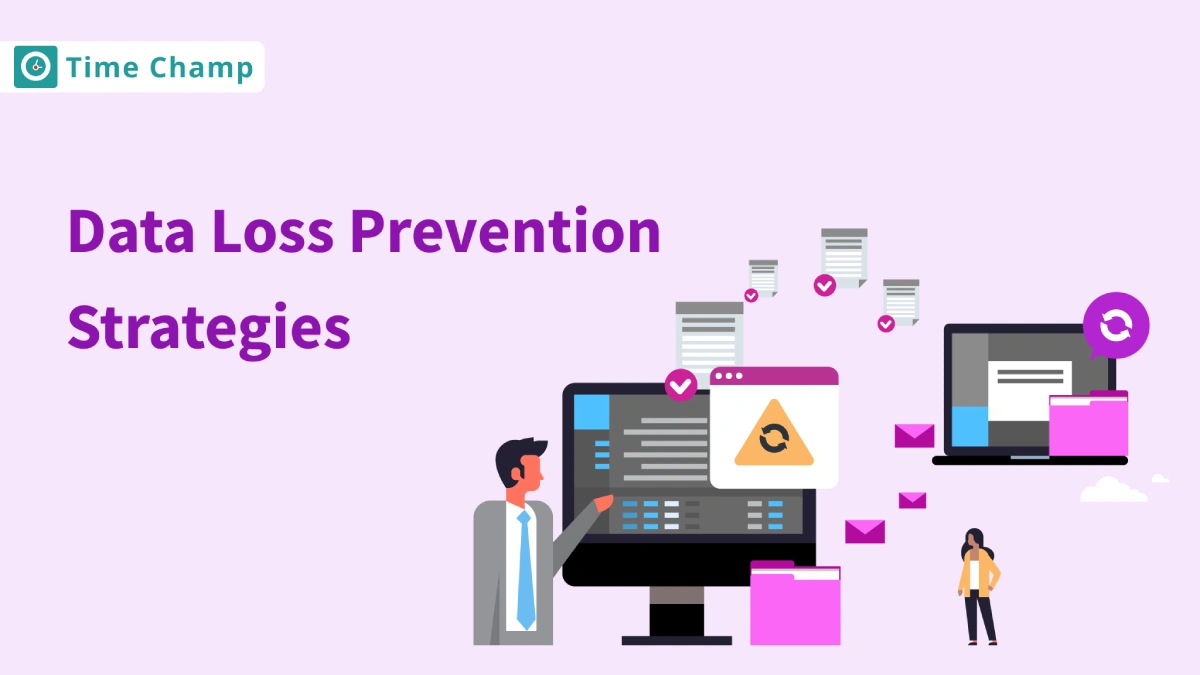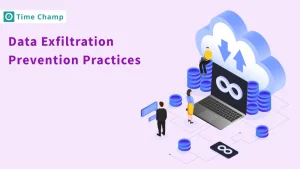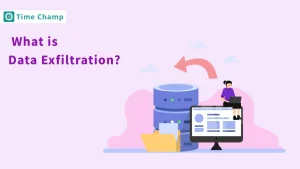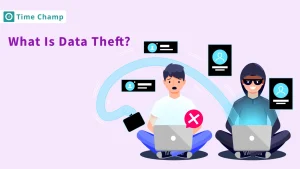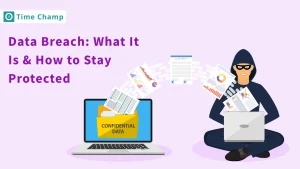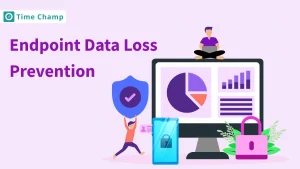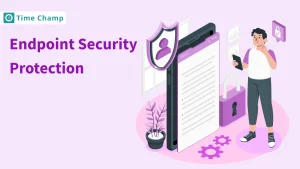Data loss prevention strategies are non-negotiable, you must secure your business at all costs.
Why?
Because the digital world we live in is unpredictable with uninformed threats and vulnerabilities around every corner, a small negligence in securing your business can cost you an arm and leg (might cost even more).
Every business is vulnerable to data loss, be it a cyber attack or an internal accident causing data loss, protecting your data is the top priority because everything runs on data nowadays.
In this blog, I will tell you about some key components and best strategies that you can implement in your organization to prevent any kind of data loss.
What is a Data Loss Prevention Strategy?
A Data Loss Prevention (DLP) strategy is a proactive approach all about keeping an organization’s sensitive information safe. It involves a mix of policies, tools, and practices that prevent unauthorized access, use, or transfer of valuable data—such as personal or financial records.
By monitoring data flow, restricting access, and using security measures like encryption, DLP strategies help prevent data breaches and ensure compliance with data protection laws. Ultimately, a DLP strategy secures essential information, minimizes risks, and builds trust with clients and stakeholders.
Key Components of an Effective Data Loss Prevention Strategy

Before jumping straight into the strategies, we need to discuss some key components because these core components make a Data Loss Prevention (DLP) strategy truly effective.
1. Identifying Sensitive Data
The first step in any effective DLP strategy is knowing what data needs protection. This involves classifying and labeling data, including unstructured PII identification , based on its sensitivity—like financial records, customer details, or intellectual property. Recognizing this kind of data is important because it lets you apply specific protective measures that directly target your organization’s crucial information.
2. Data Usage Monitoring
Watching how your data is used is key to spotting any unusual activity that might be a security risk. Data usage monitoring helps you see who’s accessing information, and how it’s being handled, and alerts you of any suspicious activities. Real-time notification alerts help you to quickly address the threats that may lead to data breaches in the future.
3. Access Control Mechanisms
Think of access control as a way to keep your sensitive information safe by making sure it’s only available to those who need it. With role-based permissions, companies can control who gets access to what data, helping to prevent accidental data leaks and cut down on the risk of data misuse. It is a simple approach to retain high safety without over-complicating access.
4. Encryption and Data Masking
With encryption and data masking, your sensitive information gets an extra layer of protection. Encryption makes data unreadable whether it’s stored or being transferred, so only the people with permission or access key can access it. Data masking hides personal information by substituting it with fictitious data that is perfect for testing without revealing real details. Collectively these measures assist in protecting your data from being compromised even if it travels outside your organization.
Steps to Develop a DLP Strategy
When it comes to keeping data safe, building a strong Data Loss Prevention (DLP) strategy is key. Here’s a guide for you to get started with the foundational steps.
1. Create a Data Handling Policy
Start by laying out clear guidelines for managing, storing, and sharing data. This policy should cover what counts as sensitive information, who can access it, and the basic rules for handling it. Simplify it by explaining what data types are personal, financial, or intellectual property and who really requires this data.
A solid data handling policy isn’t just a piece of paperwork; it’s the foundation of your DLP strategy and helps ensure secure, consistent data management across your organization. Using a data management platform can further strengthen this foundation by centralizing control, automating enforcement, and providing clear oversight of how data is accessed and used.
2. Identify Data Vulnerabilities
Every organization has areas where data could be at risk, whether it’s old security measures or too many people having access to sensitive information. It’s crucial to take a close look at how your data is stored and who can access it. This check can help uncover issues like data being stored in unsafe places, too many permissions, or weak passwords.
After that, you can apply corrective measures – such as enhanced levels of encryption or tightening the permissions to access data to keep your data protected.
3. Monitor Data Movement
Keeping an eye on how data moves inside and outside your organization is essential for spotting and stopping leaks before they become a problem. With data monitoring tools, you can track how files are shared, uploaded, or downloaded, making it easier to catch any suspicious activity that might signal unauthorized access.
This kind of monitoring also flags risky behaviors, like the sharing of files on unapproved platforms, so you can step in quickly and help keep your data safe.
4. Provide Ongoing Education
Keeping your team informed about data protection practices is one of the simplest yet most effective ways to reduce data-related risks. By Conducting regular training sessions you can keep everyone on the latest security measures and also foster a culture of security awareness.
Encourage your employees to report potential threats, and teach them to identify any incoming phishing attempts or insecure data storage and sensitivity by providing appropriate tools. Educated employees are an invaluable part of your DLP strategy, they become active participants in your organization’s security efforts.
Robust Data Loss Prevention Strategies
Now that you are fully aware of the foundational steps to develop a DLP strategy, here are some proven data loss prevention strategies that will help you secure your data and be worry-free from any security threats.
1. Deploy and Integrate a Comprehensive DLP Solution
To protect your organization’s sensitive data, start by choosing a DLP solution that fits right into your existing systems, like firewalls and antivirus software, for easy data tracking and security. A good DLP solution should automatically locate and classify sensitive data across different platforms, then keep an eye on data movement in real time. This way, if there’s any unauthorized access, you’ll know immediately and can act fast. Tailor your policies to fit your needs, so only approved users can access sensitive data especially when transferring it.
2. Set Up Access Controls and Data Encryption
You need to limit access to your company’s sensitive data. Role-Based Access Control (RBAC) lets you restrict data access based on a person’s specific role, so only those who need the data can view it. Adding Multi-Factor Authentication (MFA) makes it even tougher for anyone else to get in. Encrypting your data, whether it’s stored or being transferred, protects it from unauthorized eyes, and data masking in test environments helps keep information safe, even when it’s not in use.
Together, these practices provide a solid layer of defense against threats.
3. Regularly Fine-Tune and Update DLP Policies
A DLP strategy needs to keep up with the changes in both technology and regulations. Adjust your data loss prevention system regularly to reduce false positives and allow your security team to focus on the real issues. This way, your DLP system is always ready since policies are updated to reflect the current regulations and the organization’s requirements. Make sure you perform regular testing and software updates so that you can avoid any vulnerabilities that might pop up from nowhere, and ensure the security of your organization’s data.
4. Build a Data Monitoring and Incident Response Framework
To spot and stop threats early, track how data moves within and outside your organization. Alerts for unusual access patterns help you catch problems fast, and keeping logs of data activity makes audits and investigations much easier. Using tools like Time Champ helps you identify suspicious patterns before they become real issues.
Having a clear incident response plan is just as important. A well-practiced plan from detection to reporting helps your team handle incidents calmly and effectively. Regular drills can also keep your response team prepared, so when an actual issue arises, they’re ready to jump in and minimize any major impact.
5. Educate and Involve Employees in Data Protection
Your employees are the first line of defense in data protection. Regular training sessions keep everyone informed about the best practices and help employees spot threats like phishing. Since human error is one of the leading causes of data breaches, it’s essential to make sure everyone understands their role in protecting data. Active security awareness programs and phishing tests also ensure that data security remains fresh in the minds of your team, making them an active part of a DLP strategy.
6. Review and Adapt the DLP Strategy Continuously
A strong DLP strategy isn’t static. Regularly tracking metrics, like the number of incidents handled or threats blocked, helps measure success and identify areas to improve. Conduct routine audits to ensure your DLP strategy remains aligned with your goals and meets any regulatory requirements. It is a continuous approach of assessment that ensures your strategy remains rather adaptable to new challenges.
Use Time Champ’s DLP Solution
Protecting sensitive data shouldn’t be complicated. Time Champ’s DLP solution is a straightforward yet powerful tool that helps you keep your data safe across every part of the organization. Time Champ combines website blocking, real-time tracking, and tailored access controls, making it easier to prevent data loss and stop potential threats before they escalate.
What makes Time Champ stand out is how easily it works with your current systems, so you can start protecting data without disrupting your team’s usual workflow. As your organization grows or faces new data challenges, Time Champ helps you to keep everything secure, giving you peace of mind in today’s fast-changing digital world.
Whether you’re just starting out with data protection or looking to strengthen your current setup, Time Champ’s DLP solution adds a simple, reliable layer of security to ensure your information stays in safe hands.
Here’s what you can do with Time Champ’s DLP solution:
1. Website Blocking
You can control your employees’ access to specific distracting or harmful websites to ensure your employees focus only on their work and prevent distractions.
2. USB Device Control
You can manage USB device usage across the entire organization by either blocking access entirely or by setting up notifications when any external devices like pen drives are connected. Doing this will help you prevent unauthorized data transfers and ensure only the right people are handling all the sensitive information.
3. File System Change Monitoring
You can keep an eye on every change made to files in your system in real time, helping you spot and prevent insider threats as they happen. This way, you’ll always have a clear picture of what’s going on with your data and can protect its integrity effortlessly.
4. Attachment Control
You can also block the upload and download of attachments to prevent unauthorized sharing of data; this is very helpful in preventing insider threats, information leaking and data loss through emails or other online platforms.
5. Real-Time Screen Monitoring
You can monitor your employee screen in real time and monitor data movements to ensure data security and create a transparent workplace for everyone.
6. Suspicious Alerts
Get instant alerts for any suspicious or unusual activity detected, identify threats as soon as possible to take immediate action, and prevent potential risks.
7. Seamless Integration
Time Champ works easily with your existing tools and systems, so you can start securing data without any complicated setup or disruptions to your daily operations.
8. Incident Response Support
In case of a breach, Time Champ offers quick-response tools to help you identify, contain, and resolve data threats efficiently, so you’re always ready to act fast.
9. Scalability
As your business grows, Time Champ scales with you, adapting to new data challenges and increasing data security across the board.
Conclusion
Data, an important and private aspect of every company, and it depends on the organization to choose to disclose it or to keep it a secret. Implementing a robust data loss prevention strategy can bring you a lot of confusion if you are unaware of the key components but a robust DLP strategy is a must for protecting your organization’s valuable data. By developing clear policies, identifying vulnerabilities, monitoring data, and training your team, you create a strong defense against data loss.
Adding a tool like Time Champ’s DLP solution can take your efforts even further, keeping your sensitive information safe in today’s compromised world.
Ensure you follow the best practices for effective data loss prevention
Read our blog on DLP best practices
Click HereFrequently Asked Questions
DLP helps protect your sensitive data from being accessed or shared by unauthorized people. It uses tools to ensure that important information stays within your company and doesn’t end up in the wrong hands.
DLP checks emails before they’re sent to make sure they don’t contain any sensitive info that shouldn’t be shared. If something’s off, it stops the email from going out, making sure your data stays secure.
DLP is about keeping track of how your data moves and who can access it, while encryption takes things a step further by scrambling the data so it’s unreadable to anyone who shouldn’t have access, even if they somehow manage to get their hands on it.
It’s a good idea to review your DLP policies regularly, at least once a year. However, if there are major changes in your organization, data protection laws, or tech, it’s time to take another look to ensure everything is up to date.
Yes! Modern DLP solutions are designed to keep an eye on data stored in the cloud, making sure sensitive information stays secure even when it’s accessed from remote locations.
